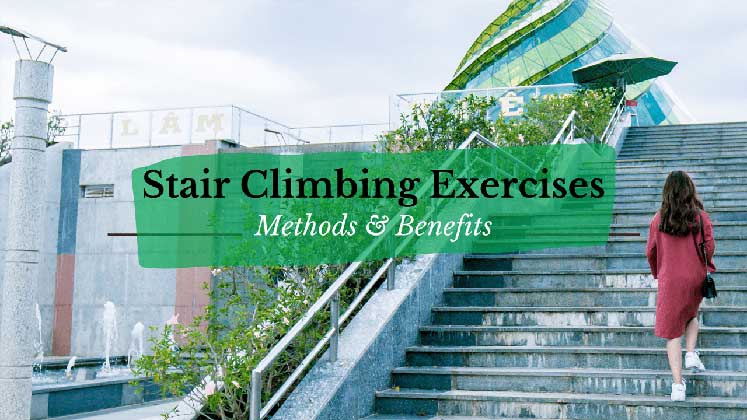
Stair climbing exercises are great for improving stamina and power. The aerobic activity is also a natural form of cardiovascular workout that consumes lots of calories and helps in weight loss. Hence, when you return home from work, prefer climbing the stairs instead of the elevator to your apartment.
Stair Climbing Exercise methods
Taking the staircase instead of the lift at the workplace is a hidden workout for you! It benefits you in relieving from many health problems. Find the most effective exercises, you can do on a staircase!
The Stair Run method
The stair-run or running upward is the easiest and productive workout to carry out at your apartment building.
How to do this exercise?
- In this practice, you have to start running upward from the place where the stairs begin.
- When you reach the last intended step, come to the start point and repeat the process.
- Practice it for three times a day with each session having a maximum duration of one minute.
- An ideal stat for this stair climbing exercise is 50 stairs.
#1 Walking Lunge method
Walking lunge method benefits thigh and buttock muscles. People with low strength should attempt it only for three stairs from the start position in the beginning.
How to do this exercise?
- Stand at the beginning of the staircase.
- Advance your right foot on the stairs bending into a lunge posture.
- Now, lean your knees to perform the repetition.
- Use your arms to balance. Again, for another leg.
- Continue this by advancing your legs until you arrive at the top of stairs.
- The maximum frequency for this stair climbing exercise is 10- times.
#2 Corner Stair Running exercise
In sideways or corner stair run exercise, runner legs, cross each other in the activity. The workout burns 78% more calorie than simple forward walking. It has a risk of falling from stairs, if not done carefully.
How to do this exercise?
- Begin at the foot of the staircase.
- Put the right side of your body near the stairs in an oblique position.
- Then, start running to the end of the stairs.
- The right foot will go first and produce a step on the stair.
- When the left foot gets close to the right foot, the right foot is again, moved for another walk.
- Repeat, until you reach the endpoint.
- Climb at least ten steps in each session and a maximum of three times.
#3 Squat Jumping method
Squat jump stair-climbing-exercise method removes fat from the lower body and shapes your butt and, legs. It helps in building stamina and balance.
How to do this exercise?
- Start at the bottom of the stairs.
- Stand in a position that your legs should open hip width-wise and your arms next to sides.
- Arrive in the squat posture and then jump on the stairs in an upward direction.
- Attempt three sets of squat jumps.
- Climb at least ten stairs in each fragment.
#4 Mountain climber method
For gaining health benefits in stair climbing, mount climber method is a useful exercise.
How to do this exercise?
- Firstly, face the stairs by placing your hand on the second footstep pressed on it.
- Legs should be in the stretched position as if you are in a push-up act.
- Then take your left knee closer to your left shoulder and then get in the initial position.
- Perform the same for the right knee as well. Repeat.
- Do ten reps and three sets of each.
#5 How many stairs should you climb a day?
One of the most common questions asked by people interested in stair exercises is how many stairs one should climb every day. A healthy person, in this regard, can take 50 stairs twice a day to get maximum benefits of stairs exercising.
Floor Climbing Exercise Advantages
Stair climbing is a great exercise routine benefiting heart rates and improving fitness. Instead of taking the lift, just a trip up and down the stairs can shape and tone the body muscles.
Benefits of climbing stairs for 20 minutes
As far as time-based criteria are concerned, you can also get benefits of climbing stairs for 20 minutes. However, make sure your exercise heart rate reaches its target zone for your age. This method will also get you in the correct health and shape.
#1 Stair workouts promotes weight loss
If you have the intention of climbing stairs for weight loss, you won’t be disappointed! Even the studies suggest stair-climbing burns more calories per minute than jogging on a treadmill.
For example – A person with 54kgs in weight can burn up to 220 calories by just by climbing stairs for 30 minutes. On the other hand, any high impact aerobic can only burn up to 190 calories.
The climbing stairs also help with saddlebags reduction in women by circulating estrogens, thereby, preventing fat accumulation in the pelvis region.
Why stairclimbing contributes to weight loss?
Canadian research reveals that climbing stairs takes twice as much energy than brisk walking and weight lifting. More energy consumption means more loss of calories that is the burning of body fat. It is the reason why most people breath heavily after climbing stairs, unlike walking.
What muscles does running stairs work?
Does stair climbing build muscle? Definitely! Stair climbing works on the bones of the legs, making them stable and hard, so they bear the weight of the body while walking against gravity.
The stair climbing build muscles in the lower body. Including a slim muscular bottom, stair climber can get a perfect buttock. Hence, stair-climbing, in particular, is useful for building quadriceps, calves, glutes, hips, and hamstrings.
#2 Climbing stairs reduce blood sugar.
Stair climbing exercises reduce blood sugar levels and improve lung capacity. Experts recommend climbing the stairs for just 10 minutes, three times a day, to make your heart healthy and strong. This way, it provides oxygen-rich blood to the muscle fibres and improves the overall health and energy level.
#3 Stair exercises increase stamina.
The stair climbing aerobic exercises is another quick way to increase the level of physical strength. Initially, climbing the stairs can make you tired even breathless sometimes. But gradually, you will feel that your stamina has increased.
#4 Stair climbing reduces migraine episodes.
The activity of stair climbing has a positive effect on individuals with headache and migraine problems. According to the National Center for Biotechnology Information (NCBI), if you have a migraine or headache problem, you can also find the benefits of climbing the stairs here. Why? Because it enhances the circulation of blood throughout the body!
#5 Mental health improvement
Stair climbing is considered the best option to keep mental health better. In fact, due to better blood circulation in the climbing body, adrenaline hormone levels increase, which makes you feel fresh. According to research, climbing stairs can relieve problems related to mental health.
Stair Climbing activity is an exercise!
Staircase climbing does not require you to go to the gym or buy workout equipment. Do not, however, underestimate the power of this hidden workout! In today’s world, when people have little or no time to exercise. In such a situation, you can fulfil the lack of physical activity by climbing stairs. Some studies say that climbing ten stairs in a day reduces the average early mortality risk [1] by 33%.
Who should not climb stairs?
People with joint problems are strictly forbidden to climb stairs, as this can worsen the condition. Individuals with low stamina should start climbing stairs slowly. Initially, climb the stairs only for five or 10 minutes on the first day and gradually increase the duration until you can sustain climbing 30 minutes daily.

Lifebing is driven by an unrelenting passion for promoting health and well-being, our team is wholly committed to curating exceptional content and immersive experiences.
